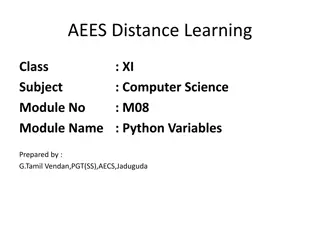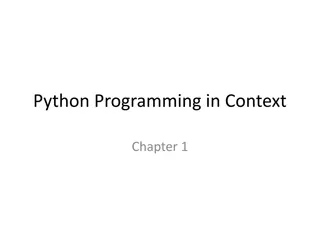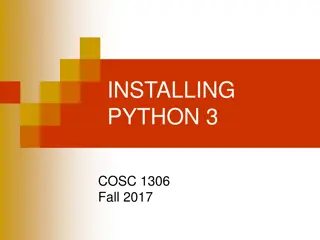
Python for Cyber Security and Analysis
Explore the use of Python in cyber security through binary analysis, forensics, malware analysis, and network analysis. Discover why Python is a preferred language for security tasks due to its efficiency and flexibility.
Download Presentation

Please find below an Image/Link to download the presentation.
The content on the website is provided AS IS for your information and personal use only. It may not be sold, licensed, or shared on other websites without obtaining consent from the author. If you encounter any issues during the download, it is possible that the publisher has removed the file from their server.
You are allowed to download the files provided on this website for personal or commercial use, subject to the condition that they are used lawfully. All files are the property of their respective owners.
The content on the website is provided AS IS for your information and personal use only. It may not be sold, licensed, or shared on other websites without obtaining consent from the author.
E N D
Presentation Transcript
Python For Security Revision + Basics
WHAT IS CYBER SECURITY? Cyber Security is the practice of defending and protecting computer systems, mobile devices, data, networks, and servers from disruptive malicious attacks. It also ensures protection from misdirection or disruption from the services provided by them.
What is Python? Python is a powerful object-oriented programming language, and it is: Cross-platform Free Interpreted: it runs directly from the source code (no need to compile it) Often used in scripting roles Easily usable in conjunction with components written in other languages
Why Python? Python is friendly. Prototyping in Python is quick. Many security tools are written in Python Adding modules is painless. Widely used (Google, NASA, Yahoo, etc) It is a multi-platform and open source language. It is a simple, fast, robust, and powerful language. Python allows penetration testers and programmers to save time by creating scripts that accelerate a job or task performance.
Python is commonly used for: Binary analysis Forensics Malware analysis Network analysis Exploring file formats Vulnerability and exploit analysis
Binary Analysis - Tasks Disassembling code Binary to Assembly Automating the analysis of code Deobfuscating code Full binary analysis frameworks have been written in Python
Forensics - Tasks File and disk analysis. Timelines Parsing the registry. Memory analysis. Analyzing memory dumps
Malware Analysis- Tasks Automating the analysis of samples in a sandbox environment. Deobfuscation, decompressing and decoding data. Debugging and disassembling. Scanning files. Extracting data.
Network Analysis- Tasks Protocol and decoding analysis Network and browser emulation. PCAP parsing. Packet creation, sniffing and manipulation. Custom passive DNS tool. Automating URL lookups
Exploring File Formats- Tasks Carving out embedded files in a data streams. Exploring structured data. Decompressing files. Writing binary parsers Analyzing and extracting firmware.
Vulnerability & Exploit Analysis Task Fuzzing Providing invalid, unexpected or random data as input to see if the data invokes exceptions or crashes Scripts. Enumerating file and network input and output Analyzing data flow and allocation of variables
The print Statement Elements separated by commas print with a space between them A comma at the end of the statement (print ( hello ),) will not print a newline character print( hello , there )
Documentation The # starts a line comment >>> 'this will print' 'this will print' >>> #'this will not' >>>
String Formatting <formatted string> % <elements to insert> Can usually just use %s for everything, it will convert the object to its String representation. >>> "One, %d, three" % 2 'One, 2, three' >>> "%d, two, %s" % (1,3) '1, two, 3' >>> "%s two %s" % (1, 'three') '1 two three' >>> %s : is assigned to strings %d :is assigned to numbers
Variables & Types Variables are simply reserved memory locations to store values. points to data stored in a memory location. There are many types of variables, such as integers, real numbers, Booleans, strings, tuples or more complex data such as lists or dictionaries. . Create a variable named x and assigns the value 10 to that variable. The second statement creates a new variable y and assigns the string Hello . x = 10 y = Hello We do not need to declare the type of the variable.
Variables & Types The same variable could first refer to an integer value, and later be assigned a different data type. Note that new assignments override any previous assignment.
Variables & Types Numbers >>> num1=22 >>> num2=33.5 >>> sum= num1+num2 >>> print("Sum of two numbers is %s"%sum) Sum of two numbers is 55.5 >>>
Variables & Types String types Strings are a sequence of characters, sentences, or words. >>> my_first="Welcome to python strings ! " >>> my_first 'Welcome to python strings ! ' >>> String Concatenation >>> userName = Mousa >>> domainName = philadelphia.edu.jo >>> userEmail = userName + @ + domainName >>> userEmail ' Mousa @ philadelphia.edu.jo
Variables & Types Strings can be declared in many different ways. 1. You can use double quotes ( string ), 2. single quotes ( string ), 3. triple single quotes ( string ) 4. triple double quotes ( string ).
Python Operators Arithmetic Operator Functions Example = + Assignment Addition Assignment a=5 Addition a + b - Subtraction Subtraction a - b * Multiplication Multiplication a * b / Division (results in float) Division a / b // Division (results in truncation) Floor Division Exponentiation a // b a ** b ** Exponentiation Modulo a % b % Modulus
Python Operators Assignment: Functions a = 0 a +=1 a -= 1 a *= 2 a /= 5 a **= 3 a //= 2 a %= 5 evaluates to a=0 evaluates to a = a + 1 evaluates to a = a + 1 evaluates to a = a * 2 evaluates to a = a / 5 evaluates to a = a ** 3 evaluates to a= a // 2 (floor division 2) evaluates to a= a % 5
Input The raw_input(string) method returns a line of user input as a string The parameter is used as a prompt The string can be converted by using the conversion methods int(string), float(string), etc. print "What's your name?" name = raw_input("> ") ~: python input.py What's your name? >Michael What year were you born? >1990 Hi Michael! You are 32 years old! print "What year were you born?" birthyear = int(raw_input("> ")) print "Hi %s! You are %d years old!" % (name, 2022 - birthyear)
Logical operators: Operator The following table summarizes the comparison and logical operators that return True or False. < Less than <= == Less than or equal Equal > Greater than >= != Greater than or equal Not equal And Logical AND Or Logical OR Not Logical NOT
Logical operators: And: True: If both the operands are true, then the condition becomes true. For example, (a and b) is true. Or: True: If any of the two operands are non-zero, then the condition becomes true. For example, (a or b) is true. Not: True: This is used to reverse the logical state of its operand. For example, not (a and b) is false. Functions and or Example a & b a | b xor a ^ b
Conditional statements The conditional statements supported by Python are as follows: 1. if condition 2. if...else condition 3. else...if conditional ladder, known as elif in Python
The if condition The if condition or the if statement takes a statement and returns either a Boolean True or a Boolean False value after evaluating the statement. if <condition> : and then indented code If the condition returns True, the code proceeding the if statement (equally indented) is executed. If the statement/condition evaluates to False, then either the else block of code gets executed if there is one, or the block of code following the if block is executed, so the if block is effectively skipped. a=44 b=33 if a > b: print("a is greater") print("End")
The if...else condition The if...else condition is pretty much the same as in any other language. If the if condition evaluates to a True value, the code block indented under if is executed. Otherwise, the code block indented under the else block is executed. Where a statement may consist of a single statement, a block of statements, or nothing (in the case of an empty statement). a=44 b=66 if a > b: print("a is Greater") print( I love Python") else: print("B is either Greater or Equal") print("End")
The if...elif condition The if...elif ladder, popularly known as if...else if in other programming languages such as C, C ++, and Java, has the same function in Python. An if condition let's specify a condition alongside the else part of the code. Only if the condition is true is the section proceeding the conditional statement executed. a=44 b=66 if a > b: print("a is Greater") elif b > a: print("B is either Greater or Equal") else: print("A and B are equal") print("End")
Loops Python offers two loops: while loop for loop As long as the condition is evaluated to True, the body of the while (statement_block) is executed repeatedly. When the condition is evaluated to False, the while loop terminates, and the post_while_statementswill be executed.
Loops while loop 5 => 5+4+3+2+1+0 => 15 1 => 1+0 => 1
Loops For loop Another loop statement is the for loop. Its general form is: Unlike many other programming languages, in Python, the for loop does not increment and test a variable against a condition on each iteration.
Loop Control Statements break Jumps out of the closest enclosing loop continue Jumps to the top of the closest enclosing loop pass Does nothing, empty statement placeholder
The Loop Else Clause The optional else clause runs only if the loop exits normally (not by break) x = 1 ~: python whileelse.py 1 2 hello while x < 3 : print x x = x + 1 else: print 'hello'
Loops for loop in the first loop, x is set to be the first item in the sequence; in the second loop, it is set to be the second item of the sequence, and so on (no matter what was its value before the loop).
Loops To write a program that calculates the exponential value (^2) of all the even numbers in the range from 0 to a given number.
The Loop Else Clause For loops also may have the optional else clause for x in range(5): print x break else : print 'i got here' ~: python elseforloop.py 1
Lists Python lists are similar to arrays in other programming languages; they are ordered collections of any type of object. Lists are data structures that hold values separated by commas inside square brackets ([]) These values can either be strings or integers.
Lists In almost every programming language, indices start from 0; this applies to Python as well. Index Element value 0 first 1 2 2 els 3 4
Lists lists can contain objects of different types. We do not need to fix its size. Python gives you the ability to append values at the end of the list. You can also remove a value from the list. >>> example = ['python', 'is', 'number', 1] >>> print (example) ['python', 'is', 'number', 1]
Lists Python implements many functions that can be used to modify a list: append: append a new element to the target list extend: allows to add one list to another insert: add a new list element right before a specific index
Lists While the previous methods can be used to add or edit list elements, the del method can be used to delete list items. Note that once elements are deleted, indices are automatically updated.
Lists The remove method is quite different from the others. It does not work with indices; instead, it looks for a given value within the list, and if this exists, it removes the element. Note that only the first instance of that value is removed.
Dictionaries The general form of a dictionary consists of one or more key:value pairs embraced in curly brackets: Where the element on the left of the of the colon is the key, and the element on the right is its associated value. As much as lists, dictionaries can store objects of any type and values are not implicitly ordered.
Dictionaries The above code shows some operations on dictionary elements. we can access an element like we did with lists, but now we have to use keys instead of indices.
Functions A function is a group of statements that gets executed when it is called (function call). The general form of a function definition is: Where: def indicates a function definition. function_name is the identifier of the function. parameters is a comma-separated list of variables. function_statements is the body of the function. return exits a function and gives the execution back to the caller.
Functions Can be assigned to a variable Can be passed as a parameter Can be returned from a function Functions are treated like any other variable in Python, the def statement simply assigns a function to a variable
Functions The program shows how to define a function that returns the sum of two numbers. Note that every function should be documented.






















